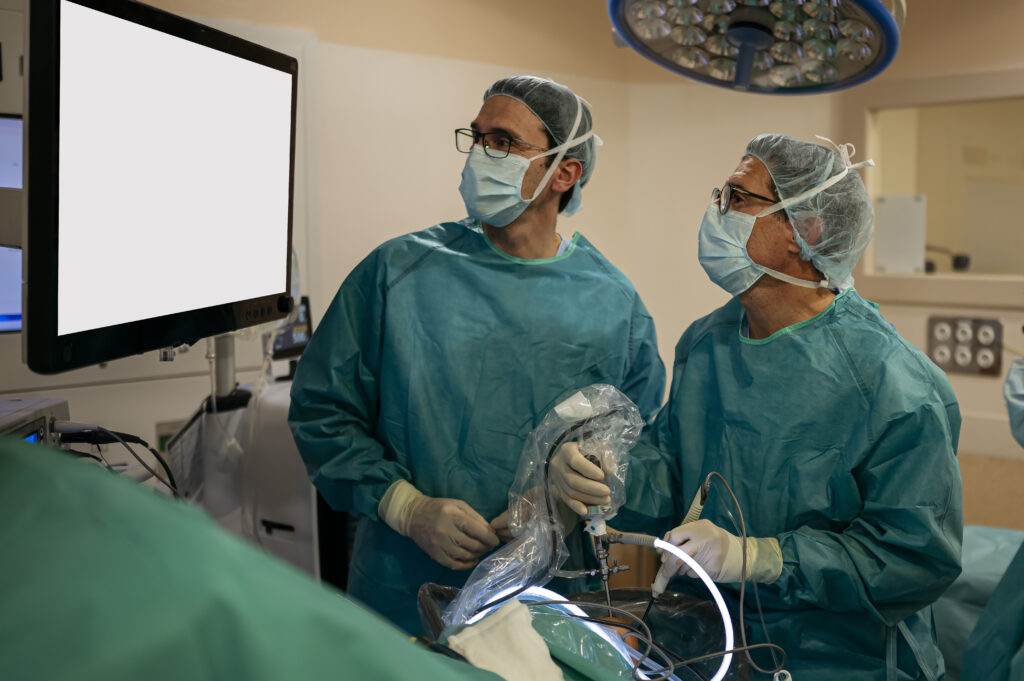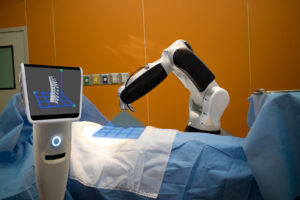Minimally invasive spine surgery has revolutionized the way spinal conditions are treated, offering patients an alternative to traditional open surgeries. Among these advancements, laser spine surgery stands out as a highly precise and less invasive option. I believe in educating my patients about the different conditions we treat, and what we treat them with, so let me explain the technology, benefits, and potential of laser spine surgery, shedding light on why it’s considered the future of spine treatment.
What is Laser Spine Surgery?
This type of surgery utilizes a focused beam of light, or laser, to remove soft tissues and small bone structures in the spine. It’s often used to relieve pressure on spinal nerves caused by conditions such as herniated discs, spinal stenosis, and other degenerative spinal disorders. Unlike traditional spine surgery, which may require large incisions and muscle disruption, laser spine surgery involves smaller incisions, leading to reduced muscle damage and less post-operative pain.
Benefits of Laser Spine Surgery
The benefits are significant, making it a preferred choice for many patients and surgeons:
Minimally Invasive: The use of lasers allows for small incisions, significantly reducing the risk of infection and blood loss. This minimally invasive approach also minimizes scarring and tissue damage.
Reduced Recovery Time: Patients typically benefit from a quicker recovery time. The less invasive nature of the procedure means that the body can heal faster, allowing you to return to normal activities faster than after traditional surgery.
Precision: The laser provides surgeons with exceptional precision. This precision ensures that only the affected spinal area is targeted, leaving surrounding healthy tissues undisturbed. This accuracy is crucial for spinal surgeries.
Less Pain: A significant benefit of laser spine surgery is the reduction in post-operative pain. Patients often report lower levels of pain after surgery, which can reduce the need for pain medication and contribute to a more comfortable recovery.
Outpatient Procedure: Many laser surgeries can be conducted on an outpatient basis. This means patients can return home on the same day as their surgery, eliminating the need for a prolonged hospital stay. This aspect of the procedure is particularly appealing to those who wish to avoid the stresses of an extended hospitalization.

Ideal Candidates
Laser spine surgery is not suitable for everyone. Ideal candidates are those with specific types of spine conditions where the nerve compression can be relieved without the need for extensive bone removal or spinal stabilization. Patients with conditions like herniated discs, lumbar spinal stenosis, and foraminal stenosis often benefit from this surgery. However, patients must undergo a comprehensive evaluation to determine if this surgery is the best option for their specific condition.
Advancements in Laser Spine Surgery Technology
Recent advancements in laser technology and spine surgery techniques have further enhanced the effectiveness and safety of laser spine surgery. These innovations include improved laser precision, enhanced imaging techniques for better surgical planning, and the integration of robotic assistance for increased accuracy.
Comparing Traditional and Laser Spine Surgery
Traditional spine surgery often involves larger incisions, more significant muscle disruption, and longer recovery times. In contrast, laser spine surgery offers a less invasive approach with smaller incisions, leading to several advantages, including reduced hospital stays, lower infection risks, and quicker return to daily activities.
Preparing for Laser Spine Surgery
Preparation involves several steps to ensure the best possible outcomes:
Medical Evaluation: A comprehensive assessment by a spine specialist is crucial. This includes a review of medical history, physical examination, and possibly diagnostic tests. The aim is to confirm the suitability of the procedure for your specific spinal condition.
Change of Routine: It may be advised to make certain routine changes before surgery. This can include stopping certain medications as advised by the doctor, quitting smoking as it can impede healing, and maintaining a balanced, healthy diet to promote better recovery.
Understanding the Procedure: This includes knowing what the procedure entails, potential risks, expected outcomes, and the recovery process. The medical team will provide detailed information and answer any questions to ensure you are thoroughly informed and comfortable with the surgical plan.
Post-Surgery Care and Recovery
Recovery from surgery is a critical phase that requires careful management to ensure optimal healing and return to daily activities. Here’s what it typically involves:
Pain Management: Immediately after surgery, managing discomfort is crucial. Patients are provided with prescribed medication, which must be taken as directed. Additionally, patients receive guidance on appropriate activity levels to avoid straining the surgical area while still promoting recovery.
Physical Therapy: Tailored exercises play a vital role in recovery. Physical therapy starts with gentle movements to enhance flexibility and gradually progresses to strengthening exercises. These exercises are designed to support the back, aid the healing process, and prevent future spinal issues.
Follow-up Appointments: Regular check-ups with the surgical team are essential. These appointments allow us to monitor the recovery progress, ensuring the surgical site is healing properly. It also provides patients with an opportunity to address any concerns or questions they may have about their recovery journey.
Lifestyle Adjustments: Post-surgery, patients may need to make certain lifestyle adjustments. This could include ergonomic changes at work or home, diet modifications, and incorporating regular low-impact exercises to maintain spinal health.

Laser Spine Surgery At The Institute For Comprehensive Spine Care
As a leading expert in spine care, I invite you to discover the transformative potential of laser spine surgery. This innovative, minimally invasive procedure could be the key to alleviating your spinal discomfort and enhancing your quality of life. My team and I are committed to providing personalized care and advanced treatment options tailored to your unique needs. Don’t let spinal issues limit your life. Contact us today to learn more about laser spine surgery and to schedule a comprehensive consultation. Together, we can explore the best path to your spinal health and well-being.
FAQ Section
Laser spine surgery is often used to treat conditions like herniated discs, spinal stenosis, and bone spurs.
It involves smaller incisions, less tissue damage, and typically results in a faster recovery and fewer complications.
Patients generally experience less pain and discomfort compared to traditional surgery, due to minimal tissue disruption.
The recovery period is usually shorter than traditional spine surgery but varies depending on the individual’s condition and overall health.
As with any surgery, there are risks, but they are generally lower due to the minimally invasive nature of the procedure.
It typically requires local or regional anesthesia, although general anesthesia may be used in some cases.








